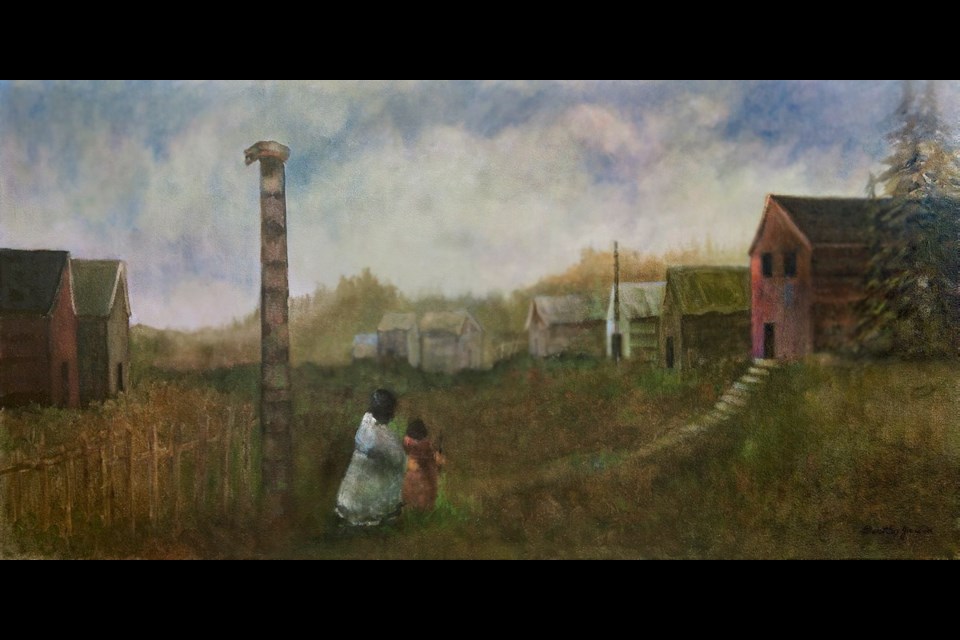 The landscape paintings of Dorothy Jarvis were hardly what I was expecting at Alcheringa Gallery. That shop is known as the leading provider of contemporary First Nations art of the highest quality, as well as carvings and much else from islands of the South Pacific. But little landscapes, in oil paint on canvas, are something I can’t recall seeing there before.
The landscape paintings of Dorothy Jarvis were hardly what I was expecting at Alcheringa Gallery. That shop is known as the leading provider of contemporary First Nations art of the highest quality, as well as carvings and much else from islands of the South Pacific. But little landscapes, in oil paint on canvas, are something I can’t recall seeing there before.
Rather than making a bold, graphic statement in stark black and red, these paintings of the Tsimshian and Gitxsan territories show us the soft, misty environment of the far northern forests.
This summer, I met Jarvis when she was one of the artists who volunteered to paint one of the public pianos that Oak Bay provides for passersby. Soft-spoken and motherly, Jarvis assured me that her piano wasn’t going to be as fog-bound as her paintings.
The resulting piano — you can see it at the gallery during her show — is mostly grey, but with more articulate detail than her canvases. On the lid, and unseen by most, she depicted a totem carved by her great uncle, William Jeffreys, lying amid the grasses, and slowly dissolving back into the earth from which it came.
Jarvis’s first solo exhibition of paintings is at Alcheringa until Nov. 9, and I was keen to learn more about her background and talent. On an appropriately rainy day, we sat among her old-time village scenes and passed the morning telling stories. Jarvis is married with two daughters and has lived with her husband in Port Alberni for the past 23 years. She’s a relative newcomer to painting, and appreciates the support and encouragement of Coastal Carvings in Coombs.
Though born in Prince Rupert, her true hometown is Lax Kw’alaams — also known as Port Simpson — which is north of Prince Rupert near the mouth of the Nass River. Her Tsimshian roots are important to her. Not long after Dorothy was born, her mother contracted tuberculosis, then distressingly common among First Nations, and was sent to Vancouver for treatment. As Jarvis said, she never came back.
So young Dorothy, who was an “only child,” grew up in the loving care of her father. He was Scottish, and spent his working life in the fisheries. Through her formative years, she often accompanied him as he made his way in the water world there, just across the straits from the northern tip of Haida Gwaii. She remembers him as “a lifelong gentle soul.”
It is a common thing in native communities for children to be raised within the extended family, often by grandparents, not least because the parents are usually fully occupied in necessary work. Dorothy was frequently in the company of her grandmother, Pearl Jeffrey, during her childhood years.
“My grandmother was an inspiration to me as a young girl,” Jarvis recalled. “She had an amazing work ethic and dedication to her family.” Among other things, Jeffrey taught Jarvis about harvesting and weaving cedar, and, in addition to her paintings, Jarvis has brought a wonderful collection of her woven cedar bracelets embellished with engraved copper and silver plaques made by her collaborator, Eric Glendale.
Despite an existence that must have been unrelenting in its hardship, Jeffrey never complained. This was a good example, and her positive attitude has come down to her granddaughter. In fact, her very name, Bel-ha, has been conferred on Jarvis by Jeffrey’s son. Bel-ha means “pearl of the ocean, landing on the whale’s tail.”
Equally inspiring was her grandmother’s brother, William Jeffrey. He was a hereditary Tsimshian chief of the people of Lax Kw’alaams, and a noted carver whose totem poles left a legacy in Prince Rupert, Vancouver, Alaska and Australia. Jarvis spent a lot of her childhood with him.
Once, when her own daughter wondered what she did to pass the time in that remote village, the artist replied: “I looked out the window.” Now, at a later stage of her life, she has been inspired to paint her vision of that world. Jarvis is making historical reconstructions of a bygone time, based on her memories and imagination.
In some of her pictures, dugout canoes are pulled up along the shoreline, and plank houses on stilts crowd the water’s edge.
“They built them up on stilts,” she told me, “so that when they went to their fishing grounds, they could take the ladders with them, and predators like bears wouldn’t come and take away their goods.”
Most of Jarvis’s paintings show village scenes of little square, post-contact houses made of sawn lumber. Often she adds a totem pole, stark and weathered, as part of the landscape. It is usually one of her great-uncle’s carvings.
In recent years she has been making trips to the area to sketch and take photographs as a basis for her imagery. It’s a quiet world, turned in on itself, where women go about their work with ravens for company. Her paintings show what she calls “a softer look at things.”
Though the lay of the land remains the same, now 1970s bungalows and intrusive automobiles take precedence in the scene, and Jarvis isn’t showing any inclination to memorialize them. On the other hand, she is not documenting the totems, as Emily Carr did, with lots of detail and an energetic modernism. She brings to her artwork fond memories and respect for a vision of the world that is fading away, “a softer approach” than we have seen before in First Nations art.
Dorothy Jarvis — Re-envisioning the Past: A Tsimshian Journey, at Alcheringa Gallery 621 Fort St. (, 250-383-8224) until Nov. 9.



